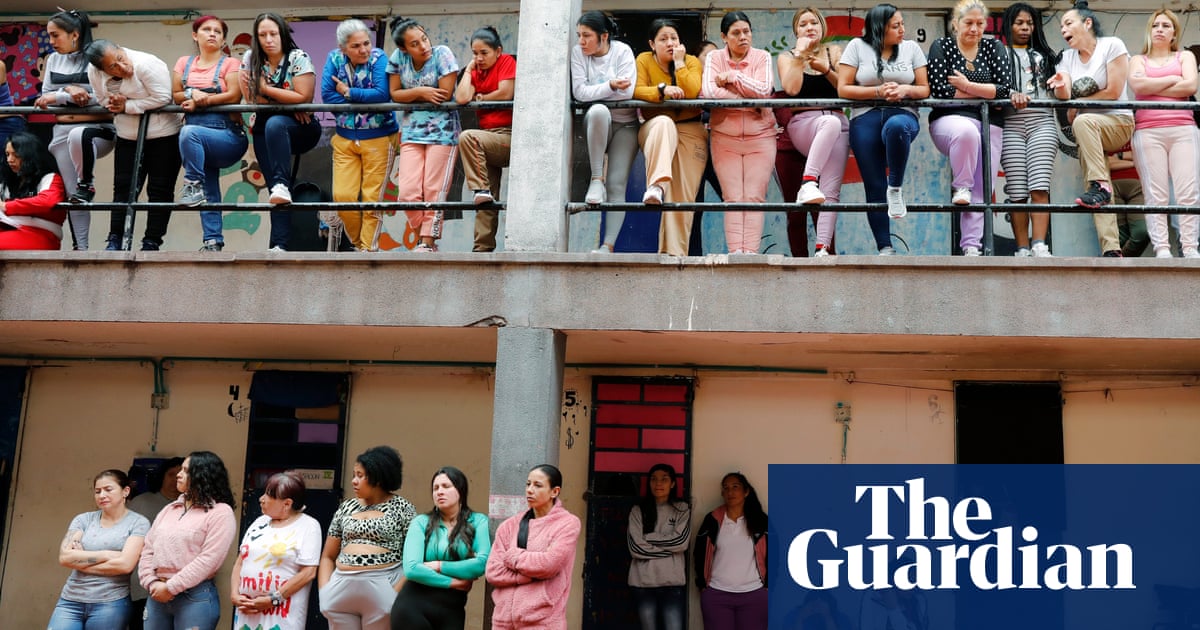The baby calls out, reaching towards a metal detector security gate. “Mama, mama,” she says. A prison officer waves her through. It’s visiting time at El Buen Pastor prison, Colombia’s largest detention centre for women. Behind the black door, half a dozen women wait anxiously. Dressed in her best clothes, the mother folds herself around the child.
Inside, the prison is crumbling. Black mould creeps up the walls; broken windows have been replaced with plastic sheets. Inmates say five to six people share cells built for two.
“It is terrible here,” says inmate Daniela Martinez. “The conditions are horrible. Once you enter, you lose hope.”
Colombia’s female prison population has increasedmore than fivefoldsince 1991, largely driven by drug laws thatdisproportionately punish women. More than a third are imprisoned for drug-related crimes; many are minor players in the trafficking chain.
The nation –which produces most of the world’s cocaine– has long been plagued by the drug trade, which has fuelled organised crime and conflict and continues to flourish.
Now Colombia’s president, Gustavo Petro, is attempting a new approach – pivoting from punishment to rehabilitation.
“Colombia has been the best student of the global drug regime, and done pretty much everything we were told to do for decades,” says Laura Gil, Colombia’s ambassador-at-large for global drug policy. “Yet today, we have record production, record consumption and record narco trafficking.
“We need to put people at the forefront instead of prisons at the forefront,” she adds.
A key reform is the Public Utility law, introduced in March 2023, to allow incarcerated women who are heads of their household and serving sentences under eight years tocomplete community service instead. It is granted primarily to women convicted of drug trafficking.
At El Buen Pastor prison, Colombia’s minister of justice Ángela María Buitrago Ruiz says a significant portion of female inmates are poor and from rural areas – where they are vulnerable to the cartels. “Many of the women here have suffered from marginality. Although in many cases they have trafficked drugs, in many cases they also did not know what they were smuggling,” she says. “We need to change the system. We need to protect women.”
Inmate Martinez was sentenced to five years and four months after 10 kilos of marijuana was found in her home. “I was tricked. I was asked to keep hold of it for someone, and then two hours later the police came,” she says. “I was a mule.”
Patricia Cortes, 23, is one of those who released under the scheme. She was freed on 17 September 2024, 11 months after she was first incarcerated for conspiracy to commit a crime, drug trafficking, manufacturing, or possession of narcotics.
Cortes says that she had been photographed alongside her mother, who had started selling narcotics to escape poverty. “Her motivation was our household needs: she had eight children, five of whom were minors, and my father had left,” she says. “She needed the money.”
Cortes says women bear the brunt of Colombia’s drug crisis, with many coerced.
In the prison chapel, the justice minister plays a video of an inmate leaving El Buen Pastor under the scheme. “Please help us and give us women who are heads of household a second chance,” she says; the inmates watching cheer in response.
“People think and say that prison is where people are rehabilitated and educated, but it is all lies. In prison, everything is denied,” says Cortes, who gave birth to her son in jail. “Many people leave prison worse than when they entered.”
Only 143 women have been released so far – 99 of whom were charged with drug offences – despite the availability of more than 2,600 community service spaces. The justice ministry blames “conservative judges” for stalling progress, while civil society leaders say the definition of “marginality” has caused difficulties in court.
“We don’t have high hopes for being released,” says Martinez. “We are more useful outside than inside; here all we do is waste time. But we have seen how many of the requests have been denied.”
Beyond the Public Utility law, Petro launched a10-year drug policyin October that proposes to change the narrative around psychoactive substances, prioritise rural development, reduce coca crops, and help small farmerstransition to the legal economy.
In March, the Colombian government also leda historic resolutionat the UN commission on narcotic drugs to suggest reforms for the existing 60-year-old system.
Civil society leaders have criticised Petro’s 10-year plan as lacking strategy. It also comes amid a deteriorating security situation that has left tens of thousands displaced, and prevents access to key coca cultivation sites.
Local people, too, wonder if the policies go far enough. In a Bogotá neighbourhood long scarred by the drug trade, people say the root of the issue is poor education.
“There are no opportunities for children to get an education here,” says Monica Urbina, 39. “They turn to drugs at 13, thinking it will give them a solution to their problem. Then they join the gangs. A lot of young people from our neighbourhoods are in jail or dead. The government needs to fix the schools first.”
Martinez, who is applying for release under the Public Utility law, agrees that more action is needed.
“Drugs affect everything in this country – families, economy, work, social life,” she says. “The government needs to work harder to break the chain.”
